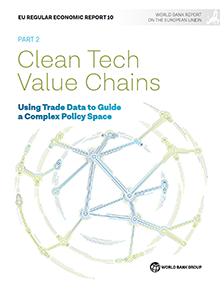Overview
Europe faces the dual challenges of helping its most vulnerable citizens recover from recent economic shocks and leveraging the growth opportunities of a green industrial future. The World Bank’s 10th EU Regular Economic Report identifies both risks to inclusive growth and the potential for clean technology to reshape economies, offering recommendations to balance social resilience with industrial renewal.

Europe’s economy is emerging from an unprecedented tightening cycle, having avoided a deep recession and widespread job losses. Growth in the EU slowed as expected in 2023, averaging a modest 0.4 percent. This decline was largely due to a reduction in trade, partly reflecting weakened export growth and loss of competitiveness from elevated energy prices. However, signs of recovery are emerging.
Headline inflation in the EU eased steadily in 2024, dropping to 2.8% by mid-year from 6.4% in 2023. Real wages are rising, and consumer spending is improving. Yet risks persist, as historically high prices continue to strain European households. By June 2024, consumer prices in Bulgaria, Croatia, Poland, and Romania had risen more than 25 percent compared to June 2021, driven by a 36 percent surge in food prices and far outpacing wage growth.
The poorest people in the EU, who spend a large part of their income on food, are feeling the greatest strain. In Romania and Poland, for instance, the bottom tenth of earners spend as much as 51 percent and 38 percent of their income, respectively, on food, leaving them particularly vulnerable. This disparity underscores the regressive impact of food inflation and poses a significant threat to the welfare of low-income households across the bloc.
Labor markets tell a similarly uneven story. Employment remains crucial for poverty reduction, yet many groups – particularly low-skilled and blue-collar workers – struggle to recover from recent shocks. Addressing the issue will require targeted policies to support vulnerable groups and ensure broader economic inclusion across the EU.
The revised Economic Governance Framework (EGF) is expected to bring new impetus to fiscal consolidation in the EU. Yet challenges persist, as policymakers must strike a delicate balance between enforcing fiscal discipline and supporting fragile growth. Meeting fiscal consolidation targets will require concrete measures on both expenditure and revenue, as sustained geopolitical and social pressures weigh on governments.

As multiple crises erode the hard-won gains of inclusive growth, the EU has an opportunity to revitalize its economy though a green and just transition. Clean energy technologies—including wind turbines, solar panels, electric vehicles, and heat pumps—are crucial to achieving net-zero emissions by 2050 and fueling a burgeoning global market worth trillions of euros annually. By strengthening its green manufacturing sector, the EU could unlock economic growth, create new jobs, boost productivity, and spur innovation across the bloc, particularly in the EU-CEE.
Major economies are pivoting toward domestic clean-tech production. While broad, horizontal policies remain vital for economic stability, they are increasingly seen as inadequate for tackling the intertwined challenges of climate change, competitiveness, inclusion, and resilience. Coupled with growing trade fragmentation and uncertainty, policymakers are turning to targeted, sector-specific strategies to drive growth in clean energy and other critical industries.
The global resurgence of industrial policy is prompting EU member states to reassess their strategies. The US Inflation Reduction Act, for example, has intensified competition for clean-tech manufacturing, prompting Europe to respond with the Net Zero Industry Act, signed in June 2024. The legislation aims to produce 40 percent of the EU’s clean-tech needs domestically by 2030 and supply 15 percent of global demand by 2040. Relaxed state aid rules further incentivize investment in clean energy industries.
The clean-tech market holds sizeable promise for Bulgaria, Croatia, Poland, and Romania. World Bank simulations suggest these countries could triple or even quadruple their clean-tech exports if they maintain or exceed current market shares. Poland already plays a critical role as an intermediary in value chains, while Bulgaria and Croatia are less integrated. Strategic industrial policies tailored to national strengths could help these countries capitalize on opportunities.
Yet, challenges loom. A coordinated EU approach is crucial to prevent fragmentation and attract vital private-sector investment. Fiscal constraints, particularly in Poland and Romania, complicate efforts further. For the EU-CEEs to meet EU targets, investments between USD $1 billion and USD $5 billion will be necessary. In addition, investors weigh numerous factors beyond government subsidies, including supply chain strength, skilled labor availability, and R&D ecosystems. Effective policies will require a mix of incentives and regulatory support, informed by data-driven analyses of industrial strengths and gaps.
An EU-wide strategy that aligns member state priorities while incorporating place-based policies could help mitigate regional disparities and enhance resilience. Tailored approaches have proven successful in other EU initiatives like cohesion policy and could help the EU-CEEs – and Europe as a whole – seize the green transition as an opportunity to bolster their economic stability and competitiveness.
Country Profiles
Bulgaria | Croatia | Poland | Romania
Previous EURER Reports
